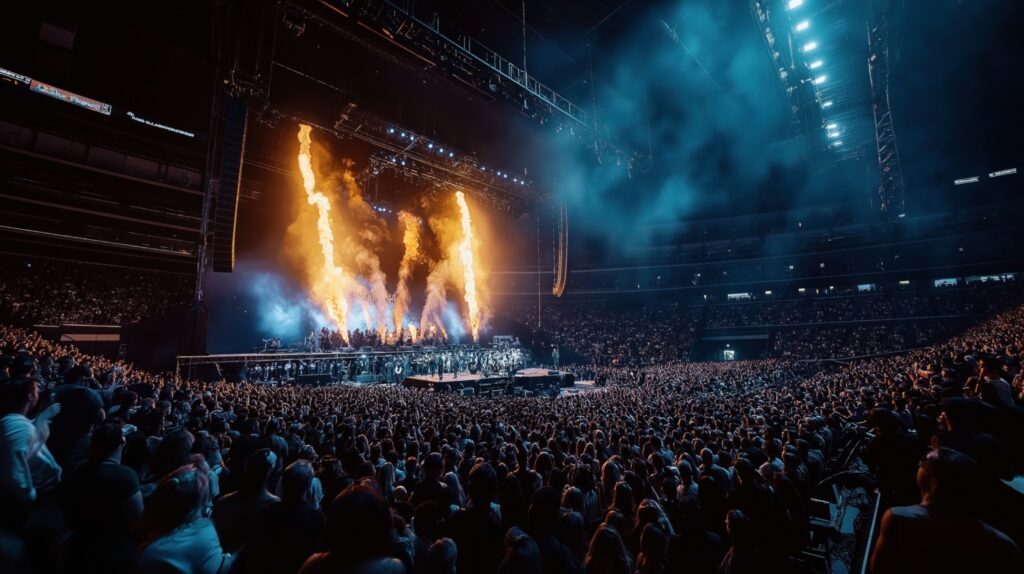Large event venues such as arenas, sports stadiums, amphitheaters, and convention centers are central to post-pandemic downtown revitalization, serving as key communal anchors in city cores.
But many of these buildings are also older and will require significant renovation, which is a great time to consider adding modern updates like resilient and sustainable design and decarbonization considerations for these large event venues. A renewed focus on rebuilding, creating spaces for the next generation of audiences, and modernizing assets with sustainable practices sums up the current opportunity before this industry.
As the large event industry continues to look for ways to reduce their overall sustainability impacts, carbon emissions, minimize climate risk, and demonstrate a financial return on their investment it is important to begin with a plan of action. A sustainability & decarbonization roadmap is exactly that!
As you plan your next venue project, no matter the stage of its lifecycle, consider these strategies for a successful decarbonization journey.
What is a Sustainability & Decarbonization Roadmap?
A sustainability and decarbonization roadmap is a strategic plan outlining how to reduce your environmental footprint and greenhouse gas emissions. It outlines the strategic steps for your facility to look internally at your current operations and practices outlining ways to achieve your goals and objectives while aiming to reduce your overall greenhouse gas emissions.
Our sustainability & decarbonization roadmap checklist is designed to give you high-impact results specifically for the sports and entertainment industry. By focusing on energy efficiency, renewable energy integration, and sustainable practices, the roadmap will kick start your sustainability & decarbonization journey.
Which Types of Sports & Event Venues Can Use This Roadmap?
This roadmap is specifically focused on the sports & entertainment market, which includes theaters, auditoriums, and concert halls, conference and convention centers, stadiums, practice facilities and other recreational facilities.
Given the number, size and iconic nature of existing buildings within this market, the roadmap is focused primarily on the operations and refurbishment of existing buildings to achieve the greatest impact. However, many of these strategies and roadmap can be applied to new construction as well.
Why Do I Need a Sustainability & Decarbonization Plan?
In certain districts, sustainability may be required for city planning applications or as part of a compliance process. But successful sports and entertainment venues should consider viewing sustainability not simply as a compliance box to check, but as an instrument of business value.
The biggest benefits of a sustainability and decarbonization strategy include cost efficiency and differentiating your venue, giving you an edge with competing venues.
Owners and operators of large entertainment and stadium venues know how competitive the market is. From competing for the best acts that draw in more people, to creating the ultimate memorable visitor experiences by paying attention to every detail, there is no room for error.

Including greener business practices not only sets your venue apart from the crowd, it is also highly cost effective. Reducing waste and energy consumption can reduce your overall operating budget as well.
What are the Components of a Sustainability & Decarbonization Roadmap?
Sustainability works best when entrenched within everything your organization does. The sustainability and decarbonization roadmap helps achieve this strategic integration.
A roadmap for sports and entertainment venues can be broken down into 6 key phases:
- Baseline Assessment of Your Assets
- Stakeholder Engagement
- Planning (or Fill in the Gaps)
- Implement (Identify Sustainability & CO2e priorities)
- Reporting
- Ongoing Tracking
Download Now: Free Sustainability & Decarbonization Roadmap Checklist for Large Venues
Each phase builds on the previous one to create a cohesive sustainability strategy. Here are the key action items for each phase:
1. Baseline Assessment of Your Assets
The first stage of the roadmap is to assess where you stand today with your current practices and building operations, including how you currently operate and manage your facility. This gap analysis might focus on water, waste, materials, energy, transportation, policies and programs including a climate risk assessment and emergency planning.
Once you understand where you are today and any opportunities that might be available pertaining to funding or incentives, you can start to document the results of the assessment gap analysis. Be prepared to share your findings in the next stage called Stakeholder Engagement.
Steps could include:
- Conduct a climate resiliency assessment of your facilities
- Conduct a building envelope assessment of your facilities
- Identify GHG baseline, including scope 1, 2 & 3 emissions
2. Stakeholder Engagement
The stakeholder engagement process is one of the most important stages overall. Stakeholders could include investors, public agencies, fans, and visitors.
At this stage, you share your findings and gap analysis with your key stakeholders, including the potential return on investment. This phase will ensure not only buy-in from key stakeholders but continued success of the sustainability and decarbonization strategy.
Successful sports and entertainment venues should consider viewing sustainability not simply as a compliance box to check, but as an instrument of business value.
Sustainability projects should demonstrate a return on investment and provide a business value to the organization. This can still include social, environmental and financial value.
It is also important to outline your timeline, including when realistically any improvements can be undertaken from an operational or capital budget viewpoint. Prioritize key initiatives and key performance indicators that you hope to achieve.
With approval and buy-in from your leadership group along with insights from your key stakeholders, you can begin to implement a plan that will eventually turn into your Sustainability & Decarbonization Roadmap. From the initial steps that you have undertaken you will begin to see a pattern of opportunities emerge and potential efficiencies and cost savings.
Steps could include:
- Conduct stakeholder engagement process
- Share findings and recommendations from the baseline assessment of your process
- Determine desired KPI’s, objectives and goals for development of sustainability & decarbonization plan.
- Establish a timeline for completion of sustainability & decarbonization roadmap
3. Planning
With the insight and direction forward from your key stakeholders you can now begin to implement the planning phase and building the structure of your sustainability and decarbonization roadmap. Think top-down (management support) and bottom up (staff engagement and implementation).
Depending on the resources at hand, you might want to consider establishing team charters. Consider this approach for the key issues that might have arisen from your stakeholder engagement process. This might have included topics such as waste reduction, energy & water upgrades and reduction, climate resiliency and transportation or master planning.
You can assign champions within your organization that would take on each initiative that you come up with and develop their own charter that would inform the sustainability and decarbonization roadmap.
Steps could include:
- Conduct existing building commissioning if recommended
- Develop a plan of action to reduce your waste stream
- Review all vendors contracts or RFPs to ensure that they address sustainability criteria

4. Implement
In this step, you get to actually implement the strategies identified in the previous phases. For example, you could reduce your waste stream by transitioning all serviceware like utensils and dishes to reusables. On the energy and decarbonization front, this might be to implement existing building commissioning on all mechanical systems or upgrade stadium lighting to more efficient LED’s to transitioning all fleet vehicles to electric.
Other potential implementation strategies include:
- Implement energy efficiency measures by identifying C02e priorities
- Implement waste management and reduction measures
- Implement any and all strategies outlined in your building performance plans
5. Reporting and Sharing Your Success
Getting support from your leadership team and stakeholders is essential not only to share your small or big wins but also to share the lessons learned, or what worked and didn’t work.
If you are public organization, you might be required to provide an annual report such as a Corporate Social Responsibility (CSR) Report or an Environmental, Social & Governance (ESG) report. This process shares and continues the path of self-reflection, keeping your goals in sight and ensuring that you are putting in the effort needed to achieve the goals and objectives outlined in the sustainability & decarbonization roadmap.
Other ways you can report and share your success:
-
-
- Establish your reporting framework depending on your market sector, and if you are a private or public organization and if there are mandates that you need to comply with.
- Find a green building or decarbonization framework that fits your needs, consider certifying your building under either:
- LEEDv5 Operations + Maintenance: Existing Buildings
- LEEDv5 Design + Construction
- Maintain an annual reporting system for tracking your progress on the sustainability & decarbonization roadmap initiatives
-
6. Ongoing Tracking
The sustainability and decarbonization roadmap might have a 5- or 10-year horizon outlined. Revisit the roadmap regularly and well in advance of this horizon to ensure you meet and maintain the strategies outlined. Be transparent with what has worked or needs improvement or complete removal.
By having your processes, reporting, and tracking documented and outlined, you can better ensure that your team and company won’t lose legacy or historical insights, even over time or with staff turnover.
Ongoing training and information sharing for your vendors, staff, and leadership team is another way to keep your prize focused on meeting the objectives outlined in the sustainability & decarbonization roadmap.
Other ways to successfully track ongoing sustainability initiatives:
- Continue to share your progress with annual reporting on how you have implemented the sustainability roadmap
- Continue to share your wins, lessons learned, and any ROI achieved
- Based upon historical evidence, adjust the roadmap as needed to ensure success
- Train and educate your vendors, staff and other stakeholders in areas where they can influence your success in ongoing implementation and rollout of strategies
- Maintain any credentialling or certification pathways that you selected
- Externally share your successes at lessons learned at trade events and conferences that are significant to your market sector
How can I implement a Decarbonization Roadmap for Large Event Venues?
Our sustainability & decarbonization roadmap checklist is a great place to start! We developed our roadmap specifically for sports & entertainment venues including large assembly venues and arenas. Connect with our sustainability experts to make sure you don’t miss anything when starting your decarbonization roadmap.
Fill in your details below to download our sustainability & decarbonization roadmap checklist.
